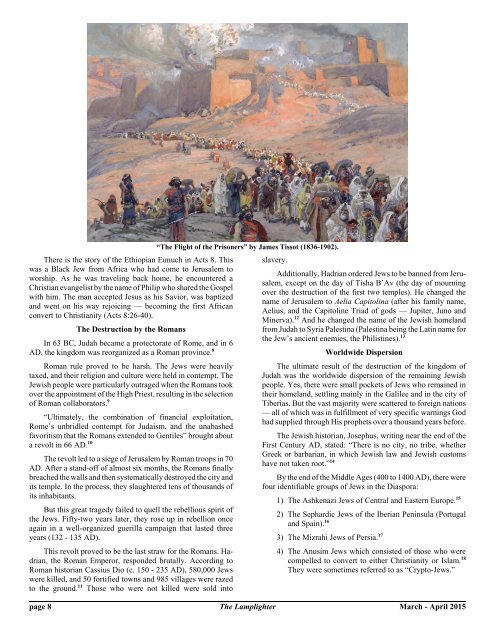Lamplighter_MarApr15_Dispersion-Jews
Lamplighter_MarApr15_Dispersion-Jews
Lamplighter_MarApr15_Dispersion-Jews
Create successful ePaper yourself
Turn your PDF publications into a flip-book with our unique Google optimized e-Paper software.
There is the story of the Ethiopian Eunuch in Acts 8. This<br />
was a Black Jew from Africa who had come to Jerusalem to<br />
worship. As he was traveling back home, he encountered a<br />
Christian evangelist by the name of Philip who shared the Gospel<br />
with him. The man accepted Jesus as his Savior, was baptized<br />
and went on his way rejoicing — becoming the first African<br />
convert to Christianity (Acts 8:26-40).<br />
The Destruction by the Romans<br />
In 63 BC, Judah became a protectorate of Rome, and in 6<br />
AD, the kingdom was reorganized as a Roman province. 8<br />
Roman rule proved to be harsh. The <strong>Jews</strong> were heavily<br />
taxed, and their religion and culture were held in contempt. The<br />
Jewish people were particularly outraged when the Romans took<br />
over the appointment of the High Priest, resulting in the selection<br />
of Roman collaborators. 9<br />
“Ultimately, the combination of financial exploitation,<br />
Rome’s unbridled contempt for Judaism, and the unabashed<br />
favoritism that the Romans extended to Gentiles” brought about<br />
a revolt in 66 AD. 10<br />
The revolt led to a siege of Jerusalem by Roman troops in 70<br />
AD. After a stand-off of almost six months, the Romans finally<br />
breached the walls and then systematically destroyed the city and<br />
its temple. In the process, they slaughtered tens of thousands of<br />
its inhabitants.<br />
But this great tragedy failed to quell the rebellious spirit of<br />
the <strong>Jews</strong>. Fifty-two years later, they rose up in rebellion once<br />
again in a well-organized guerilla campaign that lasted three<br />
years (132 - 135 AD).<br />
This revolt proved to be the last straw for the Romans. Hadrian,<br />
the Roman Emperor, responded brutally. According to<br />
Roman historian Cassius Dio (c. 150 - 235 AD), 580,000 <strong>Jews</strong><br />
were killed, and 50 fortified towns and 985 villages were razed<br />
to the ground. 11 Those who were not killed were sold into<br />
“The Flight of the Prisoners” by James Tissot (1836-1902).<br />
slavery.<br />
Additionally, Hadrian ordered <strong>Jews</strong> to be banned from Jerusalem,<br />
except on the day of Tisha B’Av (the day of mourning<br />
over the destruction of the first two temples). He changed the<br />
name of Jerusalem to Aelia Capitolina (after his family name,<br />
Aelius, and the Capitoline Triad of gods — Jupiter, Juno and<br />
Minerva). 12 And he changed the name of the Jewish homeland<br />
from Judah to Syria Palestina (Palestina being the Latin name for<br />
the Jew’s ancient enemies, the Philistines). 13<br />
Worldwide <strong>Dispersion</strong><br />
The ultimate result of the destruction of the kingdom of<br />
Judah was the worldwide dispersion of the remaining Jewish<br />
people. Yes, there were small pockets of <strong>Jews</strong> who remained in<br />
their homeland, settling mainly in the Galilee and in the city of<br />
Tiberias. But the vast majority were scattered to foreign nations<br />
— all of which was in fulfillment of very specific warnings God<br />
had supplied through His prophets over a thousand years before.<br />
The Jewish historian, Josephus, writing near the end of the<br />
First Century AD, stated: “There is no city, no tribe, whether<br />
Greek or barbarian, in which Jewish law and Jewish customs<br />
have not taken root.” 14<br />
By the end of the Middle Ages (400 to 1400 AD), there were<br />
four identifiable groups of <strong>Jews</strong> in the Diaspora:<br />
1) The Ashkenazi <strong>Jews</strong> of Central and Eastern Europe. 15<br />
2) The Sephardic <strong>Jews</strong> of the Iberian Peninsula (Portugal<br />
and Spain). 16<br />
3) The Mizrahi <strong>Jews</strong> of Persia. 17<br />
4) The Anusim <strong>Jews</strong> which consisted of those who were<br />
compelled to convert to either Christianity or Islam. 18<br />
They were sometimes referred to as “Crypto-<strong>Jews</strong>.”<br />
page 8 The <strong>Lamplighter</strong> March - April 2015


